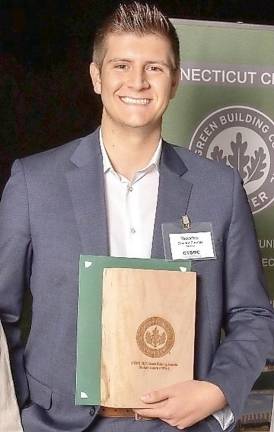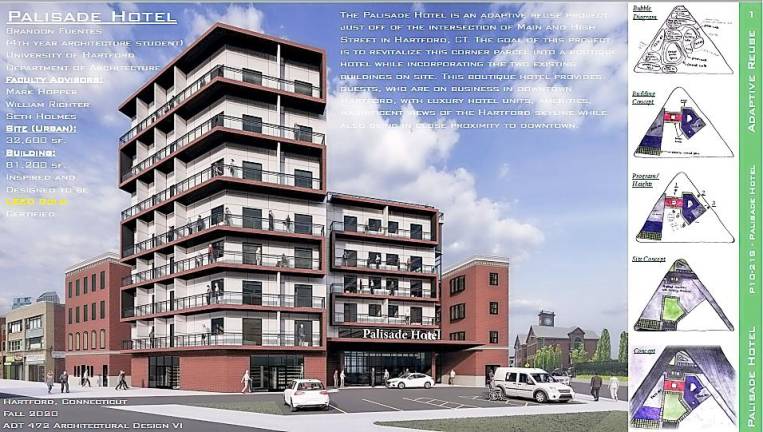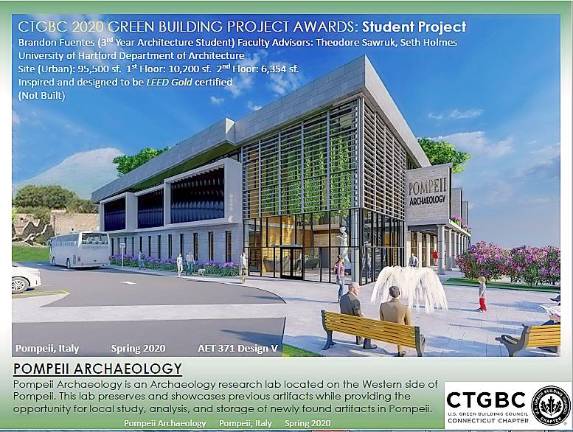Goshen’s Brandon Fuentes wins green architecture awards
Fuentes’ interest in becoming an architect was sparked by a Goshen High School class.



Goshen:--Goshen native Brandon Fuentes was finishing his advanced Master of Architecture degree at the University of Hartford last October, when he heard that he won a 2021 Student Design Award of Merit from the Connecticut Green Building Council. His theoretical redesign of an existing building for the Palisade Hotel project had attracted the judges’ attention. This is the second time Fuentes has won the award, having previously received it in 2020 for a new building design, the Pompeii Archaeology Lab project.
According to the Environmental Protection Agency, green building, whether new or renovated, is the practice of creating structures and using processes that are environmentally responsible and resource-efficient throughout a building’s lifecycle, from siting to design, construction, operation, maintenance, renovation and deconstruction. Green building design involves extensive climate and daylighting analysis, passive cooling design, and exterior and interior building performance analysis.
Fuentes, passionate about green building practices, has achieved the title of LEED (Leadership in Energy and Environmental Design) Green Associate, a credential affirming his comprehension of green building practices and principles.
Fuentes’ architectural interests began to germinate in a Goshen High School class that designed in 3D software.
“We made a beach chair out of wood,” Fuentes said. We designed it with Sketch Up software, and the Computer Numerical Control machine that dictates the movement of machinery cut out the wood pieces and we assembled a chair.”
“Just seeing pieces go from computer to real life really mesmerized me; seeing what the software was capable of doing--from that time I knew I wanted to pursue architecture as a career,” Fuentes said.
Goals
Fuentes’ say his goal as an architect is “to provide and integrate sustainable architecture, which utilizes design strategies that benefit the environment and decrease negative impacts.” At the same time, he wants to design desirable spaces people will enjoy.
His interest in making sustainable architecture blossomed as a college sophomore in a class taught by Seth Holmes. He learned about sustainable building systems and strategies and the different ways a building can be designed for sustainability. Examples include placing windows to make best use of light and warmth from the sun, along with making choices about wall material and ventilation to maximize energy efficiency in the particular locale and climate.
Prestigious Awards
For two years in a row, Fuentes has won awards for his “green” theoretical projects. He first won the Student Design Award of Merit in 2020 for the Pompeii Archaeology Project, he said. The assignment was to design a laboratory for archaeologists digging in Pompeii, blending the archaeology lab with the ruins of Pompeii. Researchers still excavating in Pompeii would have a laboratory space for examination of artifacts, as well as space to showcase and store them, he said.
In 2021, Fuentes won for his theoretical Palisades Hotel Project. He had to imagine revitalizing an existing space, incorporating two existing buildings in a new design for a boutique hotel that would benefit downtown Hartford. What made it green?
“Climate was factored in for solar orientation. Prominent winds were harnessed for passive cooling opportunities. And on the exterior, balconies provided a view as well as shading,” Fuentes said.
\He looked at daylight patterns and included or removed windows as needed. Extensive energy efficiency analysis was done for present and projected energy use and how that would affect annual costs. Fuentes was the only student who also did load-bearing calculations for the project.
Asked if there was one thing he would change about architecture education, Fuentes said, “Sustainability should be introduced early in architectural education, to prepare students for more in-depth understanding and integration in their projects. Now, more recently with climate drastically changing from human activity, there needs to be a more sustainable approach to architecture to reduce the overall carbon footprint of buildings.”
Future Plans
Having just earned his Advanced Master in Architecture degree from the University of Hartford’s College of Engineering, Technology and Architecture, Fuentes said, “I’ll probably go back to New York and look for an architectural firm that practices sustainable design.”
When he’s not designing, Fuentes enjoys golf, in which he excelled at Goshen High School.
Ed note: Fuentes would like to thank the professors and mentors who have helped him: Matthew Milnamow; John O’Rourke; Seth Holmes; Theodore Sawruk; Mark Hopper; William Richter and Daniel Davis.